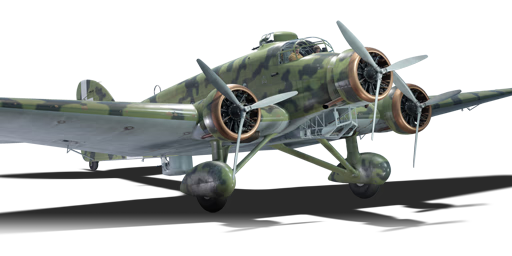




The S.81 was introduced in a time when Italy needed an aircraft capable of covering the large distances of the African Campaign, providing reconnaissance and the ability to carry bombs. Chief designer of the new project, Alessandro Marchetti developed the aircraft based on the Savoia's SM.73 airliner and militarized the vehicle for its intended use. The first prototype flew in 1935 and the aircraft was designated SM.81 Pipistrello ("Bat"). The aircraft served until 1944 with a total of 534 units built. For its time, the aircraft was considered one of the best medium bombers, but when World War II broke out it was already an outdated design. It served with Italian forces in Spain and Africa, and three were also sent to the Chinese Nationalist Forces but they were lost in training exercises in early 1938.
It was introduced in Update 1.71 "New E.R.A.". The S.81 is distinctive with its three engines, two on the wings and one in the nose. Each engine is less powerful than contemporaries on other aircraft so each engine loss will heavily impact the aircraft's speed, causing it to lose altitude, although the nose engine increases survivability. Three types of turrets are available on the S.81, a dorsal turret on top, a ventral turret on the bottom, and two beam turrets for both sides of the fuselage. All the turrets provide an excellent arc of fires on their sectors, with mutual machine gun fire from more than one turret able to be met in most areas, however these turrets only use 7.7 mm machine guns. The S.81 lacks any sort of armour and the crew is very likely to be injured in attacks, especially from below.
flaps
flaps
flaps
brake
control
| Belt | Belt filling | Armor penetration (mm) at a distance: | |||||
|---|---|---|---|---|---|---|---|
| 10 m | 100 m | 500 m | 1000 m | 1500 m | 2000 m | ||
| T/Ball/Ball/Ball/AP | 13 | 12 | 7 | 3 | 2 | 0 | |
| T/AP/AP/AP | 13 | 12 | 7 | 3 | 2 | 0 | |
| T/AP-I/AP-I/AP-I | 13 | 12 | 7 | 3 | 2 | 0 | |
| Belt | Belt filling | Armor penetration (mm) at a distance: | |||||
|---|---|---|---|---|---|---|---|
| 10 m | 100 m | 500 m | 1000 m | 1500 m | 2000 m | ||
| T/Ball/Ball/AP-I/AP | 13 | 12 | 7 | 3 | 2 | 0 | |
| T/AP/AP/AP | 13 | 12 | 7 | 3 | 2 | 0 | |
| T/AP-I/AP-I/AP-I | 13 | 12 | 7 | 3 | 2 | 0 | |












Flight performance | |
|---|---|
Survivability |
|---|
Weaponry | |
|---|---|